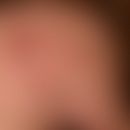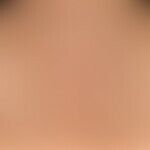Synonym(s)
HistoryThis section has been translated automatically.
DefinitionThis section has been translated automatically.
Anetoderma (from Greek aneto=slack) refers to a group of very rare, acquired, inflammatory or non-inflammatory (idiopathic), truncal, chronic connective tissue changes leading to elastolysis, resulting in circumscribed atrophy and characteristic hernia-like protrusion (also depressions) of the skin.
Very rarely, light provocability of the anetodermic foci is observed.
Medio-dermal elastolysis can also be included in the group of forms of anetoderma, which is generally characterized by more extensive foci, but does not have any significant etiopathogenetic differences from anetoderma.
You might also be interested in
EtiopathogenesisThis section has been translated automatically.
Unknown; pathogenetically, primary or postinflammatory processes lead to fragmentation and rarefaction of the skin elastic fiber network. Evidence of phagocytosis of elastic fragments in macrophages. Attachment of IgM and C3 to basement membrane, of C3 also to elastic fibers. Biochemical detection of desmosin (elastin) in lesional skin.
The occurrence of anetoderma in connection with HIV infections, syphilis as well as lichen planus and other autoimmune diseases has been described several times.
Notice. The cause of anetoderma is a (predominantly) acquired (irreversible) circumskripte (probably inflammation-induced) elastolysis.
Notice. Several cases of familiality of the disease have been described (also in association with skeletal and ocular anomalies and neurological disorders).
ManifestationThis section has been translated automatically.
Adolescents and adults (2nd-4th decade of life), female gender is preferentially affected.
ClinicThis section has been translated automatically.
Single or multiple, 0,2 cm to 1,0 cm large, sharply defined, roundish to oval flocks with often finely folded, thinned skin. Flocks partly sunken, partly hernia-like protrusion of the subcutaneous fatty tissue. The changes do not cause any complaints and are discovered rather by chance.
- Type Jadassohn: Anetodermia after inflammatory stage with redness and swelling.
- Type Pellizari: Urticarial preliminary stage.
- Type Alexander: After bullous initial stage.
- Type Schweninger-Buzzi: Without preliminary inflammatory stage.
Notice! There are legitimate doubts about the validity of the above-mentioned clinical (historical) classification; in most cases, post-inflammatory (secondary) elastolysis was involved, the causes of which remain mostly unknown!
Also a division into primary (idiopathic) and secondary (postinflammatory) anetoderms is not very satisfying from a clinical point of view, because inflammatory stages are rarely observed.
We understand anetodermia as atrophic-scarring end stage of different inflammatory processes of the skin.
HistologyThis section has been translated automatically.
Fragmentation, rarefaction and phagocytosis of the elastic fibers; in some sections elastic fibers are completely absent. Collagen fibers thinned or fragmented, with larger spaces between the fiber bundles (assessment in the Elastica-van Gieson stain). Number of fibroblasts reduced. Depending on acuity, sparse perivascular round cell infiltrates.
In medio-dermal elastolysis, the loss of elastic fibers remains limited to the middle dermis in the form of a band!
Differential diagnosisThis section has been translated automatically.
- Superficial, scarring after pyoderma, acne vulgaris or zoster
- Cutis laxa (flaccid atrophy of the healthy skin, no wrinkled surface)
- Lupus erythematosus integumentalis (healed scar stage)
- Circumscribed scleroderma (confetti type)
- Peripheral neurofibromatosis(other signs of neurofibromaosis e.g. café au lait spots)
- Lichen sclerosus et atrophicus (tpyic glossy effect of lesions)
- Goltz-Gorlin syndrome (focal dermal hypoplasia)
- Adipose tissue herniations (e.g. piezogenic nodules, foot margins)
- Corticoid atrophies (after injections, ask for orthopedic history; localizations)
- Striae cutis distensae (tearing of connective tissue during rapid growth, during pregnancy)
- Atrophodermia idiopathica et progressiva (Pasini-Pierini) (extensive, brownish, sometimes marginal plaques, atrophy of the skin only very discretely developed)
TherapyThis section has been translated automatically.
Reported several treatments! None has been shown to be effective for established lesions. Colchicine has been shown to prevent the development of new primary anetoderma lesions. In secondary anetoderma, control of the causative dermatoses should theoretically prevent the development of new lesions (Kineston DP et al 2008).
Other treatments whose efficacy has not been reexamined include cryotherapy, intralesional steroids, colchicine, hydroxychloroquine, vitamin E, oral penicillin G, epsilon-aminocaproic acid, aspirin, niacin, dapsone, and phenytoin (Braun RP et al 1998).
Established lesions can be excised for definitive treatment, but this leaves permanent scars.
Laser treatment can improve the appearance of the lesion, as shown in some case reports (Cho S et al. 2012)
LiteratureThis section has been translated automatically.
- Bilen N et al (2003) Anetoderma associated with antiphospholipid syndrome and systemic lupus erythematosus. Lupus 12: 714-716
- Braun RP et al (1998) Treatment of primary anetoderma with colchicine. J Am Acad Dermatol 38:1002-1003.
- Cho S et al (2012) Treatment of anetoderma occurring after resolution of Stevens-Johnson syndrome using an ablative 10,600-nm carbon dioxide fractional laser. Dermatol Surg 38:677-679.
- Dikarinen AI, Palatsie R, Adomian GE et al (1984) Anetoderma: biochemical and ultrastructural demonstration of elastin defect in the skin of three patients. J Am Acad Dermatol 11: 66-72.
- Emer J et al (2013) Generalized anetoderma after Intravenous Penicillin Therapy for Secondary Syphilis in an HIV Patient. J Clin Aesthet Dermatol 6:23-28.
- Fujioka M et al (2003) Secondary anetoderma overlying pilomatrixomas. Dermatology 207: 316-318
Fukayama M et al (2018) Japanese familial anetoderma: A report of two cases and review of the published work. J Dermatol 45:1459-1462.
- Ghomrasseni S et al (2002) Anetoderma: an altered balance between metalloproteinases and tissue inhibitors of metalloproteinases. Am J Dermatopathol 24: 118-129.
- Hodak E et al (2003) Primary anetoderma: a cutaneous sign of antiphospholipid antibodies. Lupus 12: 564-568
- Hunt R (2011) Circumscribed lenticular anetoderma in an HIV-infected man with a history of syphilis and lichen planus.Dermatol Online J 17: 2.
- Jadassohn J (1892) On a peculiar form of atrophia maculosa cutis. Arch Dermatol Syphilol (Berlin) 1: 342-358.
- Kasper RC et al (2001) Anetoderma arising in cutaneous B-cell lymphoproliferative disease. Am J Dermatopathol 23: 124-132.
- Kineston DP et al (2008) Anetoderma: a case report and review of the literature. Cutis 81:501-506.
- Patrizi A et al (2011) Familial anetoderma: a report of two families. Eur J Dermatol 21:680-685.
- Pellizari C (1884) Eritema orticato atrofizzante atrophia partiale idiopathica della pelle. Gior Ital Mal Ven 19: 230
- Schweninger E, Buzzi F (1881) Multiple benign tumor like new growth of the skin. In: International Atlas of rare skin diseases, part 5 plate 15. L. Voss, Leipzig.
Incoming links (16)
Anetodermia; Atrophia maculosa cutis; Atrophoderma erythemause en plaques; Berlin syndrome; Blegvad-haxthausen syndrome; Dermatitis atrophicans maculosa; Dermatitis maculosa atrophicans; Dyskeratosis congenita; Elastic fibres; Elastolysis, acquired; ... Show allOutgoing links (15)
Acne (overview); Atrophodermia idiopathica et progressiva; Atrophy of the skin (overview); Bubble; Circumscribed scleroderma; Cutaneous lupus erythematosus (overview); Cutis laxa (overview); Elastolysis mediodermal; Goltz syndrome; Lichen sclerosus (overview); ... Show allDisclaimer
Please ask your physician for a reliable diagnosis. This website is only meant as a reference.












